RENAULT TWINGO 2009 2.G Engine Diesel Injection User Guide
Manufacturer: RENAULT, Model Year: 2009, Model line: TWINGO, Model: RENAULT TWINGO 2009 2.GPages: 269
Page 11 of 269

13B-11V6 MR-413-X44-13B000$030.mif
DIESEL INJECTION
Fault finding – List and location of components13B
DCM 1.2 Injection
Program No.: 4D
Vdiag No.: 48, 4C, 50,
54, 58, 5C
Refrigerant pressure sensor:
This sensor is located on the coolant circuit.
Engine coolant temperature sensor:
This sensor is located on the cylinder head near the engine water chamber.
Accelerometer:
This sensor is located on the cylinder block.
Passenger compartment heating resistor relay:
These relays are located in the engine compartment relay unit.
Air conditioning compressor relays:
These relays are located in the engine compartment relay unit.
Fan unit relay:
These relays are located in the engine compartment relay unit.
Page 12 of 269
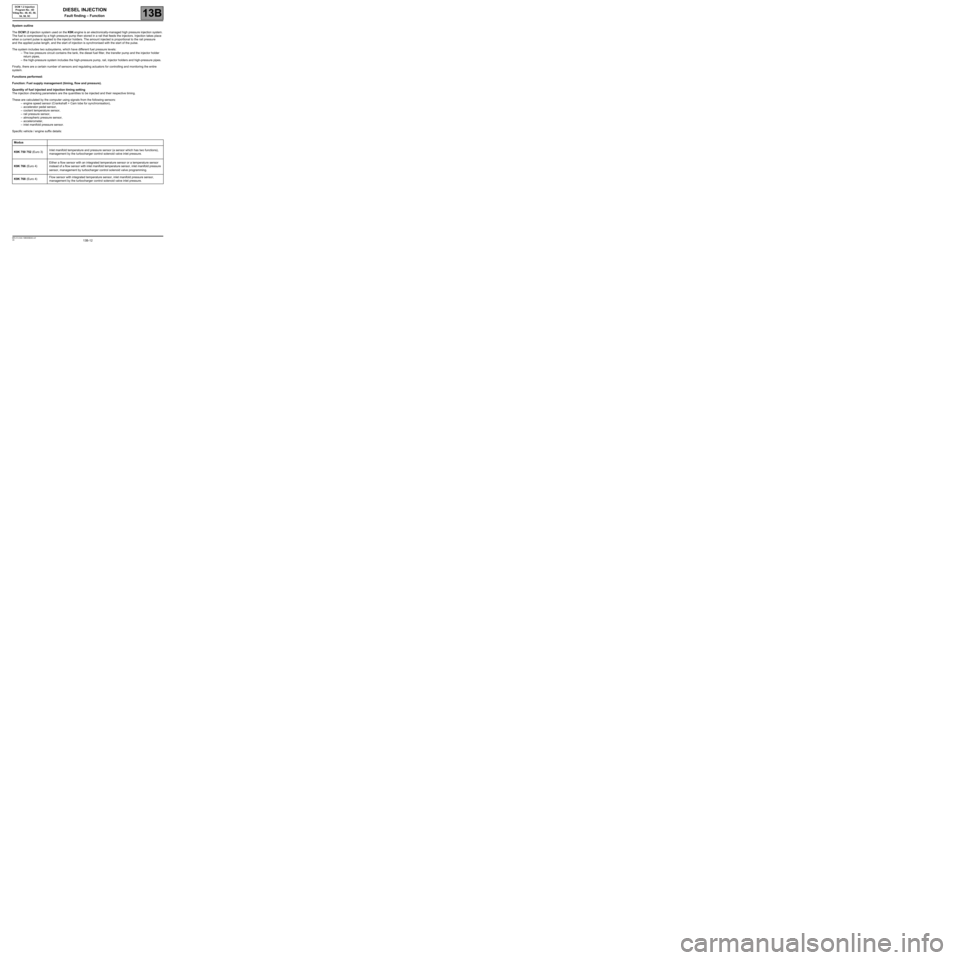
13B-12V6 MR-413-X44-13B000$040.mif
13B
DCM 1.2 Injection
Program No.: 4D
Vdiag No.: 48, 4C, 50,
54, 58, 5C
System outline
The DCM1.2 injection system used on the K9K engine is an electronically-managed high pressure injection system.
The fuel is compressed by a high pressure pump then stored in a rail that feeds the injectors. Injection takes place
when a current pulse is applied to the injector holders. The amount injected is proportional to the rail pressure
and the applied pulse length, and the start of injection is synchronised with the start of the pulse.
The system includes two subsystems, which have different fuel pressure levels:
–The low pressure circuit contains the tank, the diesel fuel filter, the transfer pump and the injector holder
return pipes,
–the high-pressure system includes the high-pressure pump, rail, injector holders and high-pressure pipes.
Finally, there are a certain number of sensors and regulating actuators for controlling and monitoring the entire
system.
Functions performed:
Function: Fuel supply management (timing, flow and pressure).
Quantity of fuel injected and injection timing setting
The injection checking parameters are the quantities to be injected and their respective timing.
These are calculated by the computer using signals from the following sensors:
–engine speed sensor (Crankshaft + Cam lobe for synchronisation),
–accelerator pedal sensor,
–coolant temperature sensor,
–rail pressure sensor,
–atmospheric pressure sensor,
–accelerometer,
–inlet manifold pressure sensor.
Specific vehicle / engine suffix details:
Modus
K9K 750 752 (Euro 3)Inlet manifold temperature and pressure sensor (a sensor which has two functions),
management by the turbocharger control solenoid valve inlet pressure.
K9K 766 (Euro 4)Either a flow sensor with an integrated temperature sensor or a temperature sensor
instead of a flow sensor with inlet manifold temperature sensor, inlet manifold pressure
sensor, management by turbocharger control solenoid valve programming.
K9K 768 (Euro 4)Flow sensor with integrated temperature sensor, inlet manifold pressure sensor,
management by the turbocharger control solenoid valve inlet pressure.
DIESEL INJECTION
Fault finding – Function
Page 13 of 269

13B-13V6 MR-413-X44-13B000$040.mif
DIESEL INJECTION
Fault finding – Function13B
DCM 1.2 Injection
Program No.: 4D
Vdiag No.: 48, 4C, 50,
54, 58, 5C
The quantities to be injected and their respective timing are converted into:
–a reference tooth,
–the time between this tooth and the start of the pulse,
–the time during which the supply to the injector holder is on.
An electrical current (pulse) is sent to each injector holder according to previously calculated data. The system
carries out one to four injections (one pilot injection, one pre-injection, one main injection, one post-injection).
The general principle is to calculate the total injection flow which is then divided between the injection stages to
promote correct combustion and reduce pollutant emissions.
An accelerometer checks some of the fuel injection deviation. This has several functions:
–Protecting the engine by detection of injection system leaks.
–Checking the quantity injected by measuring deviations and variations.
By changing both the injection duration and advance, the system readjusts the quantity of fuel injected
and the mixture's moment of ignition.Clio III
K9K 750 752 (Euro 3)Inlet manifold temperature and pressure sensor (a sensor which has two functions),
management by the turbocharger control solenoid valve inlet pressure.
K9K 766 (Euro 4)Either a flow sensor with an integrated temperature sensor or a temperature sensor
instead of a flow sensor with inlet manifold temperature sensor, inlet manifold pressure
sensor, management by turbocharger control solenoid valve programming.
K9K 768 (Euro 4)Flow sensor with integrated temperature sensor, inlet manifold pressure sensor,
management by the turbocharger control solenoid valve inlet pressure.
Megane II / Scenic II
K9K 724 (Euro 4)Either a flow sensor with an integrated temperature sensor or a temperature sensor
instead of a flow sensor with inlet manifold temperature sensor, inlet manifold pressure
sensor, management by turbocharger control solenoid valve programming.
New Twingo No UPC (Protection and Switching Unit).
K9K 740 (Euro 4)Temperature sensor instead of the flow sensor with inlet manifold pressure
and temperature sensor, management by the turbocharger control solenoid valve inlet
pressure, water in diesel fuel sensor depending on target export countries.
Kangoo 2
K9K 800 802 (Euro 4)The flow of fresh air entering the engine is given by a hot wire ratiometric sensor. This
flow sensor facilitates control of the amount of exhaust gas sent for recirculation, thus
ensuring the best possible recirculation rates. An air temperature sensor is integrated
into the flow sensor.
Air flow measurement facilitates closed-loop control via the EGR valve.
K9K 812 (Euro 3)Temperature sensor instead of the flow sensor with inlet manifold pressure
and temperature sensor, management by the turbocharger control solenoid valve inlet
pressure.
Page 14 of 269
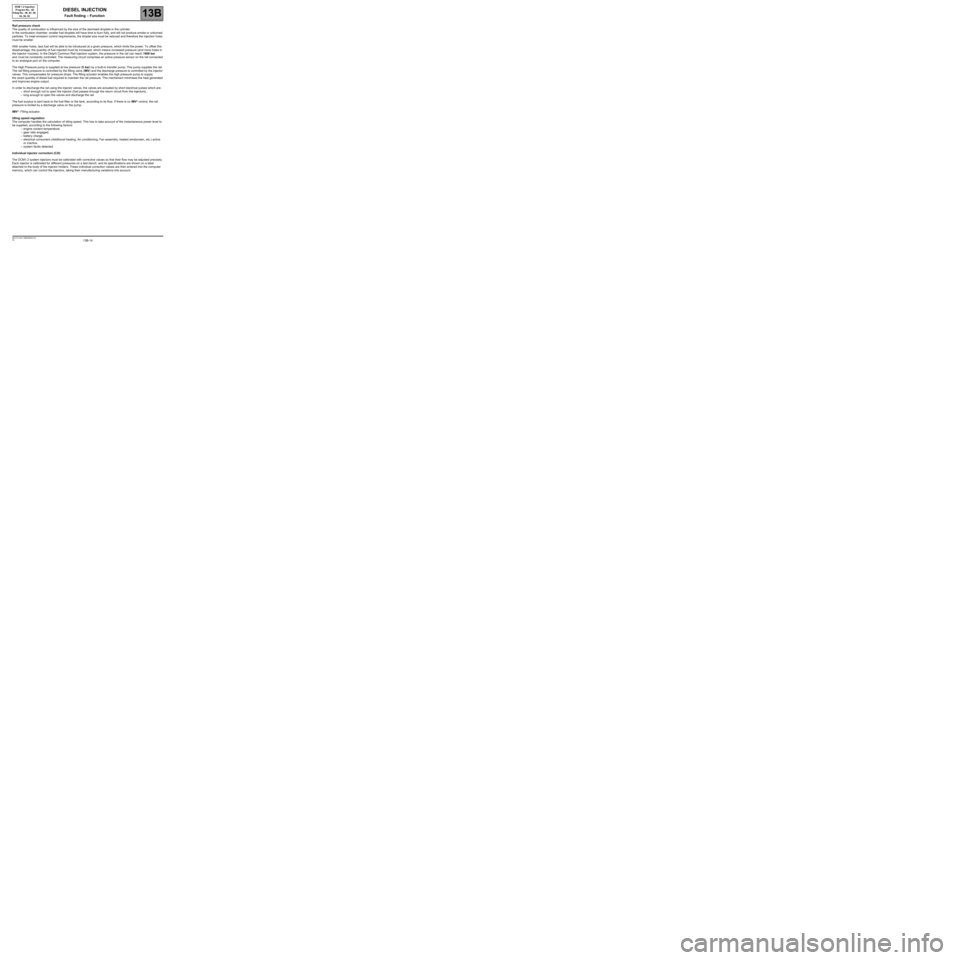
13B-14V6 MR-413-X44-13B000$040.mif
DIESEL INJECTION
Fault finding – Function13B
DCM 1.2 Injection
Program No.: 4D
Vdiag No.: 48, 4C, 50,
54, 58, 5C
Rail pressure check
The quality of combustion is influenced by the size of the atomised droplets in the cylinder.
In the combustion chamber, smaller fuel droplets will have time to burn fully, and will not produce smoke or unburned
particles. To meet emission control requirements, the droplet size must be reduced and therefore the injection holes
must be smaller.
With smaller holes, less fuel will be able to be introduced at a given pressure, which limits the power. To offset this
disadvantage, the quantity of fuel injected must be increased, which means increased pressure (and more holes in
the injector nozzles). In the Delphi Common Rail injection system, the pressure in the rail can reach 1600 bar
and must be constantly controlled. The measuring circuit comprises an active pressure sensor on the rail connected
to an analogue port on the computer.
The High Pressure pump is supplied at low pressure (5 bar) by a built-in transfer pump. This pump supplies the rail.
The rail filling pressure is controlled by the filling valve (IMV) and the discharge pressure is controlled by the injector
valves. This compensates for pressure drops. The filling actuator enables the high pressure pump to supply
the exact quantity of diesel fuel required to maintain the rail pressure. This mechanism minimises the heat generated
and improves engine output.
In order to discharge the rail using the injector valves, the valves are actuated by short electrical pulses which are:
–short enough not to open the injector (fuel passes through the return circuit from the injectors),
–long enough to open the valves and discharge the rail.
The fuel surplus is sent back to the fuel filter or the tank, according to its flow. If there is no IMV* control, the rail
pressure is limited by a discharge valve on the pump.
IMV*: Filling actuator.
Idling speed regulation
The computer handles the calculation of idling speed. This has to take account of the instantaneous power level to
be supplied, according to the following factors:
–engine coolant temperature,
–gear ratio engaged,
–battery charge,
–electrical consumers (Additional heating, Air conditioning, Fan assembly, heated windscreen, etc.) active
or inactive,
–system faults detected.
Individual injector correction (C2I)
The DCM1.2 system injectors must be calibrated with corrective values so that their flow may be adjusted precisely.
Each injector is calibrated for different pressures on a test bench, and its specifications are shown on a label
attached to the body of the injector holders. These individual correction values are then entered into the computer
memory, which can control the injectors, taking their manufacturing variations into account.
Page 15 of 269
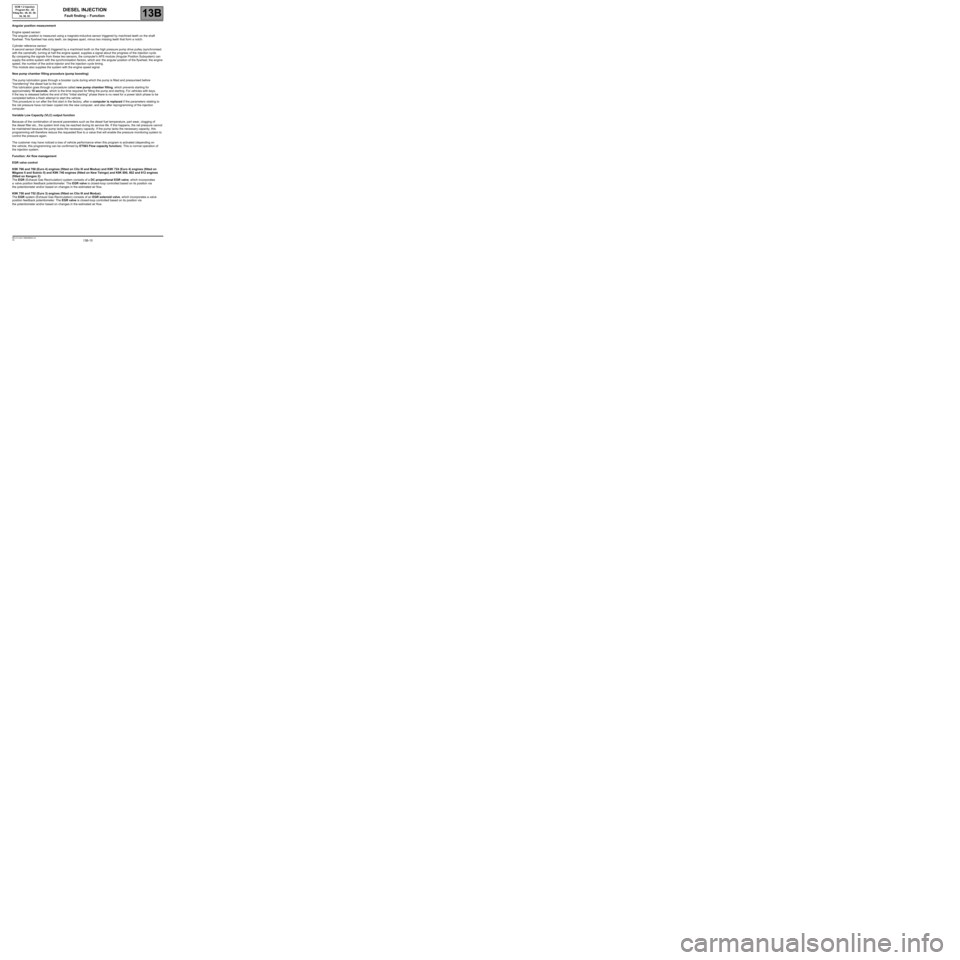
13B-15V6 MR-413-X44-13B000$040.mif
DIESEL INJECTION
Fault finding – Function13B
DCM 1.2 Injection
Program No.: 4D
Vdiag No.: 48, 4C, 50,
54, 58, 5C
Angular position measurement
Engine speed sensor:
The angular position is measured using a magneto-inductive sensor triggered by machined teeth on the shaft
flywheel. This flywheel has sixty teeth, six degrees apart, minus two missing teeth that form a notch.
Cylinder reference sensor:
A second sensor (Hall effect) triggered by a machined tooth on the high pressure pump drive pulley (synchronised
with the camshaft), turning at half the engine speed, supplies a signal about the progress of the injection cycle.
By comparing the signals from these two sensors, the computer's APS module (Angular Position Subsystem) can
supply the entire system with the synchronisation factors, which are: the angular position of the flywheel, the engine
speed, the number of the active injector and the injection cycle timing.
This module also supplies the system with the engine speed signal.
New pump chamber filling procedure (pump boosting)
The pump lubrication goes through a booster cycle during which the pump is filled and pressurised before
"transferring" the diesel fuel to the rail.
This lubrication goes through a procedure called new pump chamber filling, which prevents starting for
approximately 10 seconds, which is the time required for filling the pump and starting. For vehicles with keys,
if the key is released before the end of this "initial starting" phase there is no need for a power latch phase to be
completed before a fresh attempt to start the vehicle.
This procedure is run after the first start in the factory, after a computer is replaced if the parameters relating to
the rail pressure have not been copied into the new computer, and also after reprogramming of the injection
computer.
Variable Low Capacity (VLC) output function
Because of the combination of several parameters such as the diesel fuel temperature, part wear, clogging of
the diesel filter etc., the system limit may be reached during its service life. If this happens, the rail pressure cannot
be maintained because the pump lacks the necessary capacity. If the pump lacks the necessary capacity, this
programming will therefore reduce the requested flow to a value that will enable the pressure monitoring system to
control the pressure again.
The customer may have noticed a loss of vehicle performance when this program is activated (depending on
the vehicle, this programming can be confirmed by ET563 Flow capacity function). This is normal operation of
the injection system.
Function: Air flow management
EGR valve control
K9K 766 and 768 (Euro 4) engines (fitted on Clio III and Modus) and K9K 724 (Euro 4) engines (fitted on
Mégane II and Scénic II) and K9K 740 engines (fitted on New Twingo) and K9K 800, 802 and 812 engines
(fitted on Kangoo 2):
The EGR (Exhaust Gas Recirculation) system consists of a DC proportional EGR valve, which incorporates
a valve position feedback potentiometer. The EGR valve is closed-loop controlled based on its position via
the potentiometer and/or based on changes in the estimated air flow.
K9K 750 and 752 (Euro 3) engines (fitted on Clio III and Modus):
The EGR system (Exhaust Gas Recirculation) consists of an EGR solenoid valve, which incorporates a valve
position feedback potentiometer. The EGR valve is closed-loop controlled based on its position via
the potentiometer and/or based on changes in the estimated air flow.
Page 16 of 269
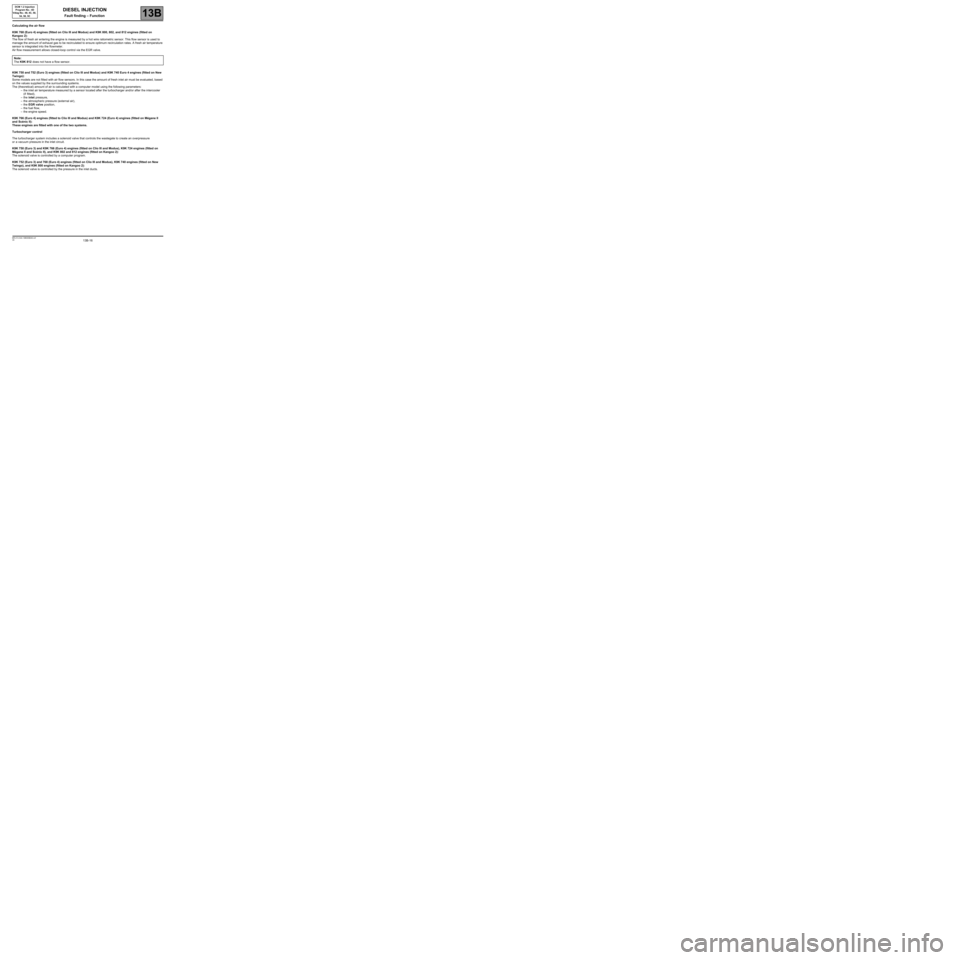
13B-16V6 MR-413-X44-13B000$040.mif
DIESEL INJECTION
Fault finding – Function13B
DCM 1.2 Injection
Program No.: 4D
Vdiag No.: 48, 4C, 50,
54, 58, 5C
Calculating the air flow
K9K 768 (Euro 4) engines (fitted on Clio III and Modus) and K9K 800, 802, and 812 engines (fitted on
Kangoo 2):
The flow of fresh air entering the engine is measured by a hot wire ratiometric sensor. This flow sensor is used to
manage the amount of exhaust gas to be recirculated to ensure optimum recirculation rates. A fresh air temperature
sensor is integrated into the flowmeter.
Air flow measurement allows closed-loop control via the EGR valve.
K9K 750 and 752 (Euro 3) engines (fitted on Clio III and Modus) and K9K 740 Euro 4 engines (fitted on New
Twingo):
Some models are not fitted with air flow sensors. In this case the amount of fresh inlet air must be evaluated, based
on the values supplied by the surrounding systems.
The (theoretical) amount of air is calculated with a computer model using the following parameters:
–the inlet air temperature measured by a sensor located after the turbocharger and/or after the intercooler
(if fitted),
–the inlet pressure,
–the atmospheric pressure (external air),
–the EGR valve position,
–the fuel flow,
–the engine speed.
K9K 766 (Euro 4) engines (fitted to Clio III and Modus) and K9K 724 (Euro 4) engines (fitted on Mégane II
and Scénic II):
These engines are fitted with one of the two systems.
Turbocharger control
The turbocharger system includes a solenoid valve that controls the wastegate to create an overpressure
or a vacuum pressure in the inlet circuit.
K9K 750 (Euro 3) and K9K 766 (Euro 4) engines (fitted on Clio III and Modus), K9K 724 engines (fitted on
Mégane II and Scénic II), and K9K 802 and 812 engines (fitted on Kangoo 2):
The solenoid valve is controlled by a computer program.
K9K 752 (Euro 3) and 768 (Euro 4) engines (fitted on Clio III and Modus), K9K 740 engines (fitted on New
Twingo), and K9K 800 engines (fitted on Kangoo 2):
The solenoid valve is controlled by the pressure in the inlet ducts.Note:
The K9K 812 does not have a flow sensor.
Page 17 of 269
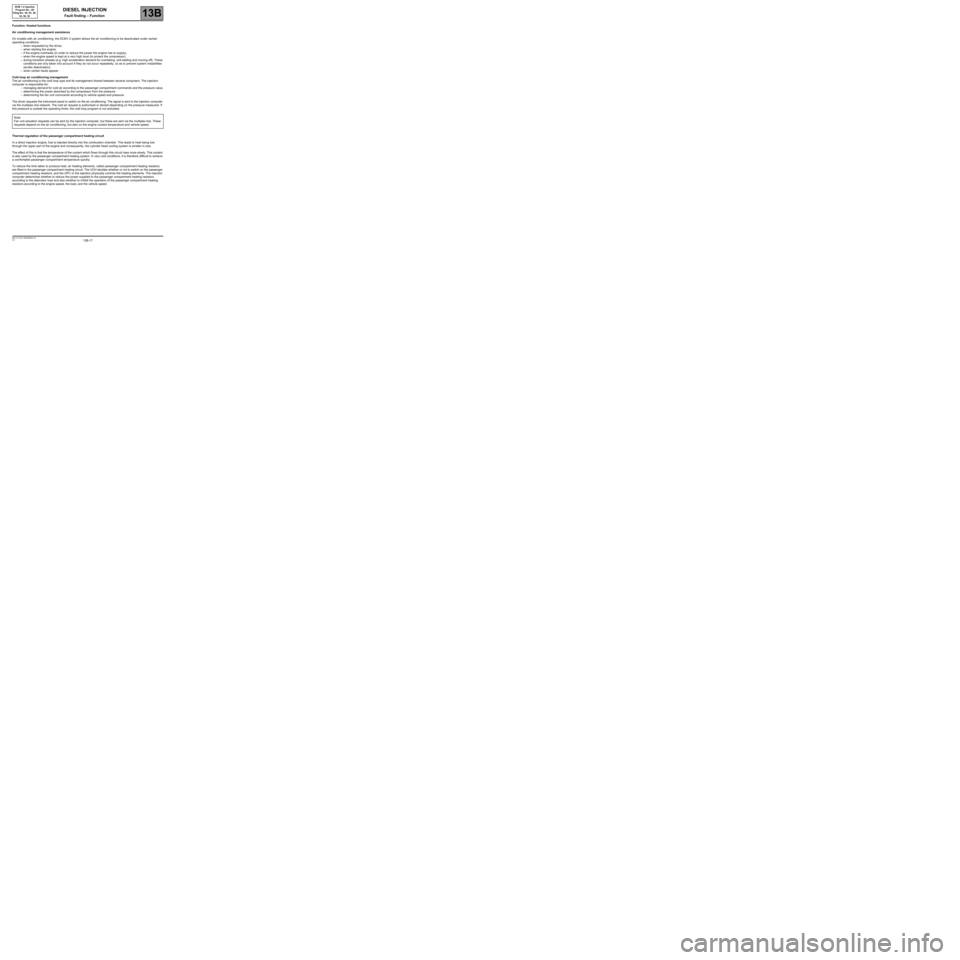
13B-17V6 MR-413-X44-13B000$040.mif
DIESEL INJECTION
Fault finding – Function13B
DCM 1.2 Injection
Program No.: 4D
Vdiag No.: 48, 4C, 50,
54, 58, 5C
Function: Hosted functions
Air conditioning management assistance
On models with air conditioning, the DCM1.2 system allows the air conditioning to be deactivated under certain
operating conditions:
–when requested by the driver,
–when starting the engine,
–if the engine overheats (in order to reduce the power the engine has to supply),
–when the engine speed is kept at a very high level (to protect the compressor),
–during transition phases (e.g. high acceleration demand for overtaking, anti-stalling and moving off). These
conditions are only taken into account if they do not occur repeatedly, so as to prevent system instabilities
(erratic deactivation),
–when certain faults appear.
Cold loop air conditioning management
The air conditioning is the cold loop type and its management shared between several computers. The injection
computer is responsible for:
–managing demand for cold air according to the passenger compartment commands and the pressure value,
–determining the power absorbed by the compressor from the pressure,
–determining the fan unit commands according to vehicle speed and pressure.
The driver requests the instrument panel to switch on the air conditioning. The signal is sent to the injection computer
via the multiplex line network. The cold air request is authorised or denied depending on the pressure measured. If
this pressure is outside the operating limits, the cold loop program is not activated.
Thermal regulation of the passenger compartment heating circuit
In a direct injection engine, fuel is injected directly into the combustion chamber. This leads to heat being lost
through the upper part of the engine and consequently, the cylinder head cooling system is smaller in size.
The effect of this is that the temperature of the coolant which flows through this circuit rises more slowly. This coolant
is also used by the passenger compartment heating system. In very cold conditions, it is therefore difficult to achieve
a comfortable passenger compartment temperature quickly.
To reduce the time taken to produce heat, air heating elements, called passenger compartment heating resistors,
are fitted in the passenger compartment heating circuit. The UCH decides whether or not to switch on the passenger
compartment heating resistors, and the UPC or the injection physically controls the heating elements. The injection
computer determines whether to reduce the power supplied to the passenger compartment heating resistors
according to the alternator load and also whether to inhibit the operation of the passenger compartment heating
resistors according to the engine speed, the load, and the vehicle speed.Note:
Fan unit actuation requests can be sent by the injection computer, but these are sent via the multiplex line. These
requests depend on the air conditioning, but also on the engine coolant temperature and vehicle speed.
Page 18 of 269
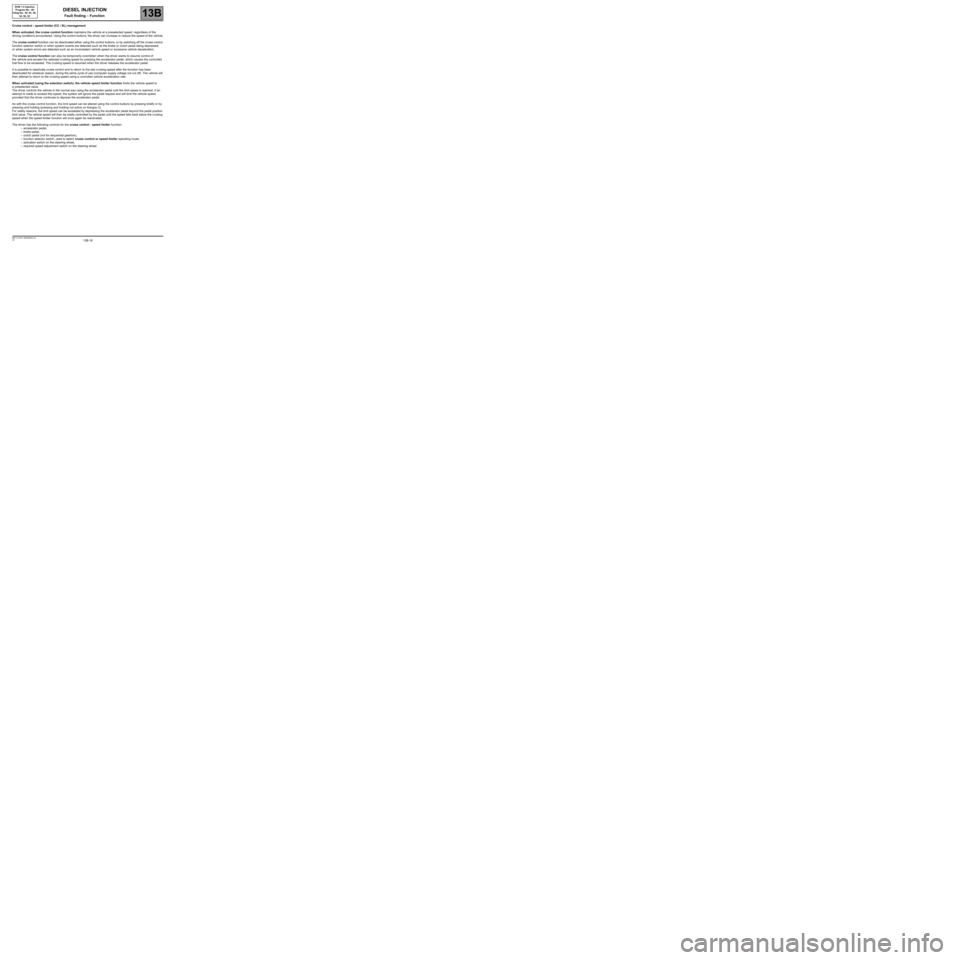
13B-18V6 MR-413-X44-13B000$040.mif
DIESEL INJECTION
Fault finding – Function13B
DCM 1.2 Injection
Program No.: 4D
Vdiag No.: 48, 4C, 50,
54, 58, 5C
Cruise control - speed limiter (CC / SL) management
When activated, the cruise control function maintains the vehicle at a preselected speed, regardless of the
driving conditions encountered. Using the control buttons, the driver can increase or reduce the speed of the vehicle.
The cruise control function can be deactivated either using the control buttons, or by switching off the cruise control
function selector switch or when system events are detected such as the brake or clutch pedal being depressed,
or when system errors are detected such as an inconsistent vehicle speed or excessive vehicle deceleration.
The cruise control function can also be temporarily overridden when the driver wants to resume control of
the vehicle and exceed the selected cruising speed by pressing the accelerator pedal, which causes the controlled
fuel flow to be exceeded. The cruising speed is resumed when the driver releases the accelerator pedal.
It is possible to reactivate cruise control and to return to the last cruising speed after the function has been
deactivated for whatever reason, during the same cycle of use (computer supply voltage not cut off). The vehicle will
then attempt to return to the cruising speed using a controlled vehicle acceleration rate.
When activated (using the selection switch), the vehicle speed limiter function limits the vehicle speed to
a preselected value.
The driver controls the vehicle in the normal way using the accelerator pedal until the limit speed is reached. If an
attempt is made to exceed this speed, the system will ignore the pedal request and will limit the vehicle speed,
provided that the driver continues to depress the accelerator pedal.
As with the cruise control function, the limit speed can be altered using the control buttons by pressing briefly or by
pressing and holding (pressing and holding not active on Kangoo 2).
For safety reasons, the limit speed can be exceeded by depressing the accelerator pedal beyond the pedal position
limit value. The vehicle speed will then be totally controlled by the pedal until the speed falls back below the cruising
speed when the speed limiter function will once again be reactivated.
The driver has the following controls for the cruise control - speed limiter function:
–accelerator pedal,
–brake pedal,
–clutch pedal (not for sequential gearbox),
–function selector switch, used to select cruise control or speed limiter operating mode,
–activation switch on the steering wheel,
–required speed adjustment switch on the steering wheel.
Page 19 of 269
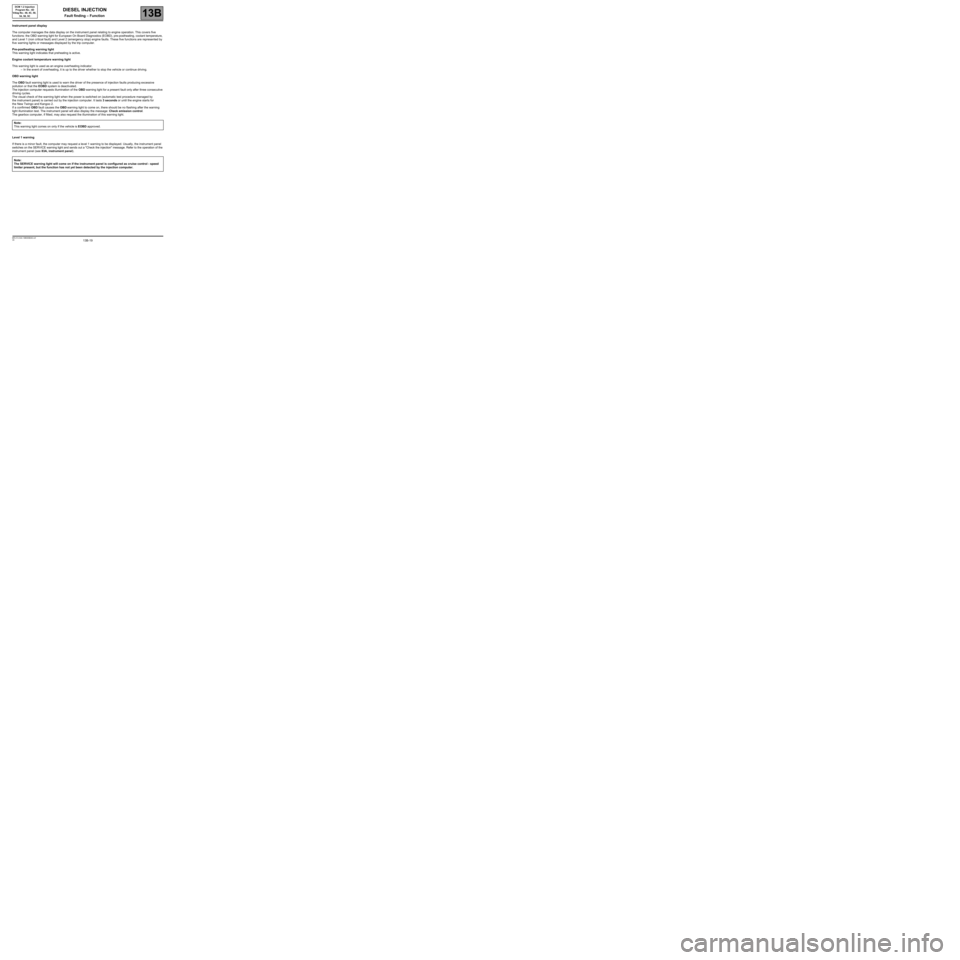
13B-19V6 MR-413-X44-13B000$040.mif
DIESEL INJECTION
Fault finding – Function13B
DCM 1.2 Injection
Program No.: 4D
Vdiag No.: 48, 4C, 50,
54, 58, 5C
Instrument panel display
The computer manages the data display on the instrument panel relating to engine operation. This covers five
functions: the OBD warning light for European On Board Diagnostics (EOBD), pre-postheating, coolant temperature,
and Level 1 (non critical fault) and Level 2 (emergency stop) engine faults. These five functions are represented by
five warning lights or messages displayed by the trip computer.
Pre-postheating warning light
This warning light indicates that preheating is active.
Engine coolant temperature warning light
This warning light is used as an engine overheating indicator.
–In the event of overheating, it is up to the driver whether to stop the vehicle or continue driving.
OBD warning light
The OBD fault warning light is used to warn the driver of the presence of injection faults producing excessive
pollution or that the EOBD system is deactivated.
The injection computer requests illumination of the OBD warning light for a present fault only after three consecutive
driving cycles.
The visual check of the warning light when the power is switched on (automatic test procedure managed by
the instrument panel) is carried out by the injection computer. It lasts 3 seconds or until the engine starts for
the New Twingo and Kangoo 2.
If a confirmed OBD fault causes the OBD warning light to come on, there should be no flashing after the warning
light illumination test. The instrument panel will also display the message: Check emission control.
The gearbox computer, if fitted, may also request the illumination of this warning light.
Level 1 warning
If there is a minor fault, the computer may request a level 1 warning to be displayed. Usually, the instrument panel
switches on the SERVICE warning light and sends out a "Check the injection" message. Refer to the operation of the
instrument panel (see 83A, instrument panel). Note:
This warning light comes on only if the vehicle is EOBD approved.
Note:
The SERVICE warning light will come on if the instrument panel is configured as cruise control - speed
limiter present, but the function has not yet been detected by the injection computer.
Page 20 of 269
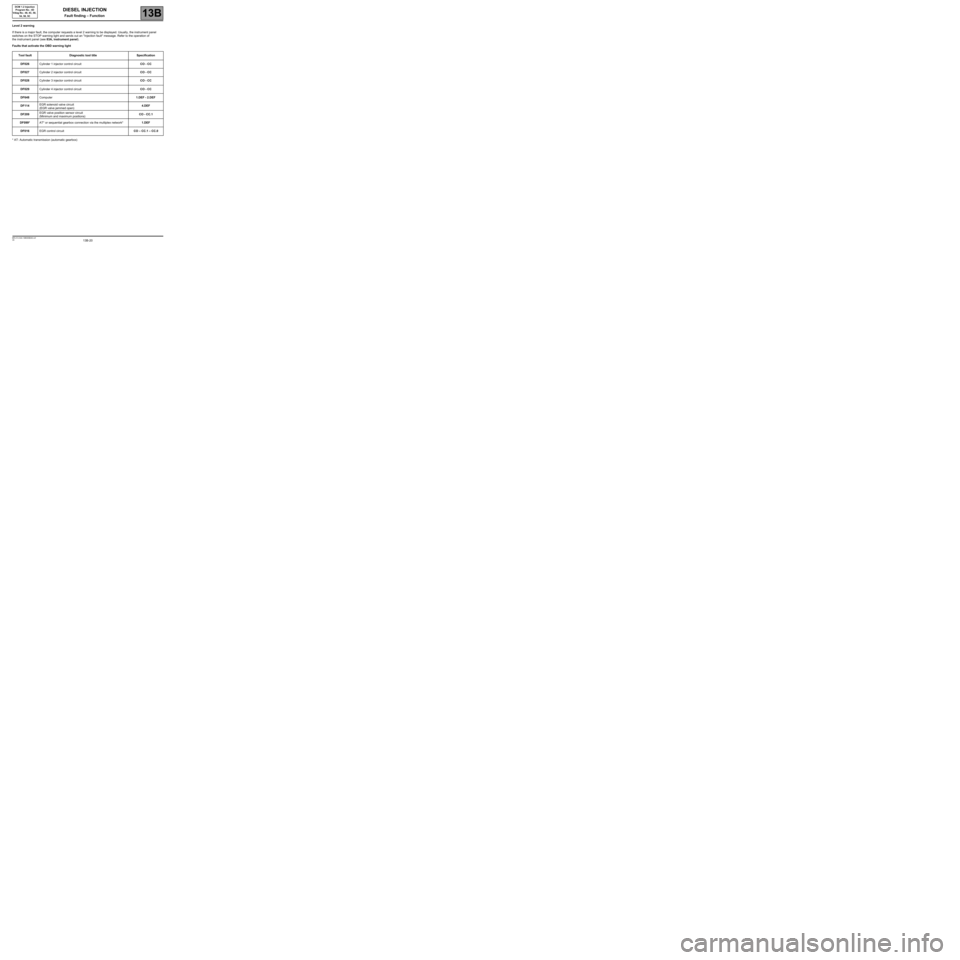
13B-20V6 MR-413-X44-13B000$040.mif
DIESEL INJECTION
Fault finding – Function13B
DCM 1.2 Injection
Program No.: 4D
Vdiag No.: 48, 4C, 50,
54, 58, 5C
Level 2 warning
If there is a major fault, the computer requests a level 2 warning to be displayed. Usually, the instrument panel
switches on the STOP warning light and sends out an "Injection fault" message. Refer to the operation of
the instrument panel (see 83A, instrument panel).
Faults that activate the OBD warning light
* AT: Automatic transmission (automatic gearbox)Tool fault Diagnostic tool title Specification
DF026Cylinder 1 injector control circuitCO - CC
DF027Cylinder 2 injector control circuitCO - CC
DF028Cylinder 3 injector control circuitCO - CC
DF029Cylinder 4 injector control circuitCO - CC
DF648Computer1.DEF - 2.DEF
DF114EGR solenoid valve circuit
(EGR valve jammed open)4.DEF
DF209EGR valve position sensor circuit
(Minimum and maximum positions)CO - CC.1
DF099*AT* or sequential gearbox connection via the multiplex network*1.DEF
DF016EGR control circuitCO – CC.1 – CC.0